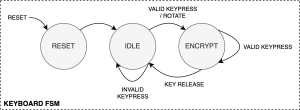This was a very productive week! On Monday, Nancy and I fixed the bug we were facing last week with the rotary encoder not wrapping around from Z to A. We also added the RTL for the enigma rotor starting, rotor number, and ring position to display on the MAX seven segment display. We then implemented the rotary encoder modules with the rest of our integrated RTL. We are currently facing a few issues/glitches with the integration between how values are displayed on the MAX seven segment when the rotary encoder is turned.
On Wednesday, Tanisha had finished running tests on the completed PCB and Nancy and I worked on integrating the current code and started working on the lampboard shift register logic. On Friday, Nancy and I started working on the shift register logic — we started with a single shift register with 8 LEDs hooked up on a breadboard. By Friday afternoon, we finished expanding this to the full PCB lampboard, here is a video of the lamboard integrated with the FPGA + PS2 keyboard.
Also, on Wednesday, I also created a CAD model of the wood housing for the PCB and FPGA and laser cut it on Saturday. Below is a picture of the wood housing with the FPGA inside and the PCB mounted on top!
I have learned so much over the course of this semester. One of the first challenges was hooking up the FPGA with all of the peripherals which required learning how to decipher several protocols (PS2, SPI). To do this I looked through old git repos and read lots of documentation and datasheets. The RTL we wrote for this project was much different than in any of the other hardware classes I’ve taken so far because of all the integration we had to do. This RTL also had to be synthesized on real hardware (which I haven’t done since 240) which had its own share of issues and required lots of heavy debugging and time spent on Reddit forums. I also learned how to CAD and use the laser cut software (CoralDraw) this semester for laser cutting the housing. I watched videos online to figure out how to CAD using onShape. I also asked some of my mechanical engineering friends for tips on how to make box joints. For laser cutting in TechSpark, I asked TechSpark employees for help and other students for help using the machine.










